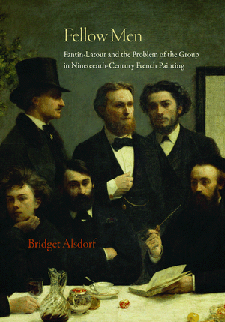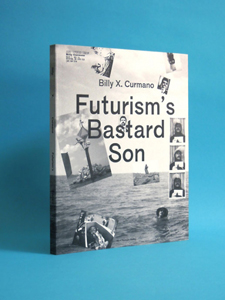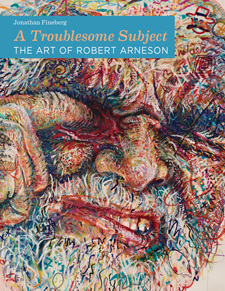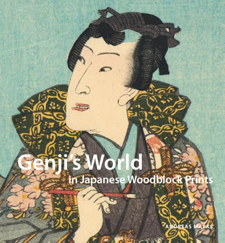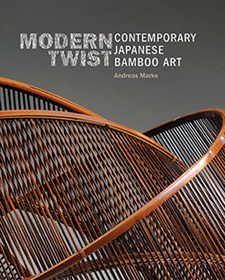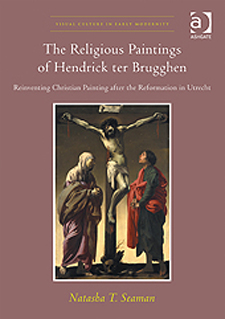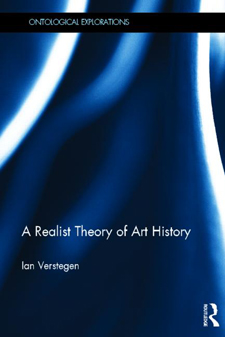CAA News Today
Exhibitions Curated by CAA Members
posted by CAA — February 15, 2013
Check out details on recent shows organized by CAA members who are also curators.
Exhibitions Curated by CAA Members is published every two months: in February, April, June, August, October, and December. To learn more about submitting a listing, please follow the instructions on the main Member News page.
February 2013
Reni Gower. Papercuts. Ritter Art Gallery, University Galleries, School of the Arts, Florida Atlantic University, Boca Raton, Florida, January 19–March 2, 2013.
Andreas Marks. Modern Twist: Contemporary Japanese Bamboo Art. Bellevue Arts Museum, Bellevue, Washington, November 13, 2012–February 3, 2013.
Barbara McPhail. No Land Escapes. Ink Shop, Ithaca, New York, February 1–March 29, 2013.
Stephen Petersen. Gertrude Käsebier: The Complexity of Light and Shade. Old College Gallery, University of Delaware, Newark, Delaware, February 6–June 28, 2013.
Books Published by CAA Members
posted by CAA — February 15, 2013
Publishing a book is a major milestone for artists and scholars—browse a list of recent titles below.
Books Published by CAA Members appears every two months: in February, April, June, August, October, and December. To learn more about submitting a listing, please follow the instructions on the main Member News page.
February 2013
Bridget Alsdorf. Fellow Men: Fantin-Latour and the Problem of the Group in Nineteenth-Century French Painting (Princeton, NJ: Princeton University Press, 2012).
Billy X. Curmano. Futurism’s Bastard Son (Vienna: Mark Pezinger Verlag, 2012).
Jonathan Fineberg. A Troublesome Subject: The Art of Robert Arneson (Berkeley: University of California Press, 2013).
Andreas Marks. Genji’s World in Japanese Woodblock Prints (Leiden, the Netherlands: Hotei, 2012).
Andreas Marks with Margalit Monroe. Modern Twist: Contemporary Japanese Bamboo Art (Washington, DC: International Arts and Artists, 2012).
Natasha Seaman. The Religious Paintings of Hendrick ter Brugghen: Reinventing Christian Painting after the Reformation in Utrecht (Burlington, VT: Ashgate, 2012).
Ian Verstegen. A Realist Theory of Art History (New York: Routledge, 2013).
“Publishing The Art Bulletin” Launches
posted by Christopher Howard — February 13, 2013
 This year marks the one hundredth anniversary of the first issue of The Art Bulletin, CAA’s flagship journal of art-historical scholarship. “Publishing The Art Bulletin: Past, Present, and Future,” an ambitious online project, has just launched to celebrate the occasion. The project employs a deep exploration of the journal’s hundred-year archive to stimulate thinking about the forms that a future Art Bulletin might take.
This year marks the one hundredth anniversary of the first issue of The Art Bulletin, CAA’s flagship journal of art-historical scholarship. “Publishing The Art Bulletin: Past, Present, and Future,” an ambitious online project, has just launched to celebrate the occasion. The project employs a deep exploration of the journal’s hundred-year archive to stimulate thinking about the forms that a future Art Bulletin might take.
Three outstanding essays—by Ananda K. Coomaraswamy (1939), Mehmet Aga-Oglu (1945), and Suzanne Preston Blier (1993)—stand at the heart of the project, which also features an array of features possible only in a digital format. Thelma K. Thomas, an associate professor in the Institute of Fine Arts at New York University and chair of the Art Bulletin Editorial Board, created the website in collaboration with the Scalar project of the Alliance for the Networking of Visual Culture and the University of Southern California, which helped fund the project.
News from the Art and Academic Worlds
posted by Christopher Howard — February 13, 2013
Each week CAA News publishes summaries of eight articles, published around the web, that CAA members may find interesting and useful in their professional and creative lives.
Interview with NEA Chief of Staff Jamie Bennett
With Rocco Landesman’s announcement to step down from the chairmanship of the NEA, can you reflect on the major accomplishments of his and your tenure and assess the impact—current and future—on the field? What do you see as unfinished business at the agency? (Read more at Barry’s Blog.)
Artists in Egypt Work in a Tense Atmosphere
The Muslim women in Marwa Adel’s photographs are shadows, repressed by custom, religion, marriage, and regret. While nude, the figures are obscured by sepia scrims, scrawled upon with stifling words—as if their true selves may never be known. Like their creator, a single mother edging at the bounds of artistic freedom in a patriarchal society, the images are at once vulnerable and defiant. (Read more in the Los Angeles Times.)
Decompressing Salaries
It’s a dilemma many universities face: how to attract new, top faculty with competitive salaries without being unfair to senior professors, whose salaries often are tied to a pay scale or plan that hasn’t kept up with the outside market. Weighing recruiting needs against a desire to alleviate the morale-busting effect of salary compression on faculty, one Midwest university has launched a series of initiatives to address it. (Read more at Inside Higher Ed.)
In Search of a Good Critique
From the hiring side of the table, we’ve all seen job candidates who seem to be doing well only to fall flat in one venue: they ace the teaching demo and the dinner meeting but stumble during the research talk. Perhaps the candidate was disorganized, too strident, or just long winded and boring. Whatever the cause, the outcome is a strong negative ding when it comes time to vote on the hire. (Read more in the Chronicle of Higher Education.)
Less Is More: The Rise of the Very Limited Edition
Good design used to be a simple matter. Was the object easy to use? Simple in appearance? Made from high-quality materials? Value for money? Those were the important questions. But today design is significantly more complex. Before a product ever gets to a consumer, it has usually been subjected to investment analysis, prototype development, focus-group discussion, and advertising campaigns. (Read more in the Art Newspaper.)
Why It’s Time for Galleries to Dump the Jargon
Do you like nature, and art? If so, you might like something called On Vanishing Land, produced by the British “sound artists and theorists” Mark Fisher and Justin Barton. What they’ve produced, which will be in an art gallery called the Showroom, is “a new form of sonic fiction from the dreamings, gleamings, and prefigurations that pervade the Suffolk coast.” Themes “of incursion” by “unnameable forces, geological sentience, or temporary anomaly” will, apparently, “recur throughout.” (Read more in the Independent.)
Help Desk: A Uniform Presentation
My question concerns the issue of a “signature style” and the importance of projecting an image of consistency, particularly on one’s personal website. I’ve done a lot of different things and tend to work in the medium that I feel best expresses what I am trying to communicate. As a result, I’ve got a real mix of things: photos, text-based pieces, assemblages/sculptures, some video work. While I can personally see the threads of consistency running through the work, I’ve been cautioned that I need to “grow up, pick one thing, and get known for it.” (Read more at Daily Serving.)
The Price of a Bad Review
Librarian questions quality of a publishing house. Librarian publicly criticizes said press on his personal blog. Two years later, librarian and current employer get sued for libel and damages in excess of $4 million. That’s been the progression of events for Dale Askey, associate university librarian at McMaster University in Ontario, where he’s been working since 2011. (Read more at Inside Higher Ed.)
Board of Directors Election Ends on Friday
posted by Vanessa Jalet — February 11, 2013
The annual CAA Board of Directors election will end at 5:00 PM (EST) on Friday, February 15, 2013. To participate, all you need is your CAA member ID number and password. Visit the board-election page or click the candidates’ names below to read their statements, biographies, and endorsements—and to watch their video presentations—before casting your vote.
- Elizabeth Conner, Artist and Instructor, University of Washington Tacoma
- Constance Cortez, Associate Professor of Art History, Texas Tech University
- Jennifer Milam, Professor of Art History, University of Sydney
- Debra Riley Parr, Chair of the Fashion Studies Department, Columbia College Chicago
- Sheila Pepe, Artist and Acting Assistant Dean for Academic Affairs, School of Art and Design, Pratt Institute
- John Richardson, Professor and Chair of the Department of Art and Art History, Wayne State University
How to Vote
Log into your CAA account with your CAA User ID# and password. Then click the Vote Now image at the center of your screen to begin the process. If you are already logged in, click the Home link at left, and then the Vote Now link.
You may vote for up to four candidates, including one write-in candidate if you wish. Ballots that indicate more than four candidates will be voided. The election ends at 5:00 PM (EST) on Friday, February 15, 2013.
Send your Proxy
CAA encourages you to attend the Annual Members’ Business Meeting at the 2013 Annual Conference in New York. If you cannot attend, please check the box appointing a proxy. By doing so, you appoint the CAA board officers named thereon—Anne Collins Goodyear, Patricia McDonnell, DeWitt Godfrey, Jacqueline Francis, Randall C. Griffin, and Maria Ann Conelli—to vote, in their discretion, on such matters as may properly come before such a meeting.
A quorum of one hundred members is needed to hold the meeting; therefore CAA kindly requests your proxy to ensure the meeting can take place. Please send your proxy by 5:00 PM EST on Friday, February 15, 2013. Thank you.
CAA Celebrates Its Fifty-Year Members
posted by Christopher Howard — February 08, 2013
CAA warmly thanks the many contributions of the following dedicated members who joined CAA in 1963 or earlier. This year, the annually published list welcomes seventeen artists, scholars, and curators whose distinguished exhibitions, publications, and teaching practices have shaped the direction and history of art over the last fifty years.
1963: Lilian Armstrong; Richard Brilliant; Eric G. Carlson; Dean Carter; Vivian L. Ebersman; Lois M. Fink; Françoise Forster-Hahn; Walter S. Gibson; Caroline M. Houser; Susan Koslow; Osmund Overby; E. Solomon; Lauren Soth; Richard E. Spear; Virginia Stotz; Roxanna A. Sway; and Roger A. Welchans.
1962: Jo Anne Bernstein; Phyllis Braff; Jacquelyn C. Clinton; Shirley S. Crosman; Frances D. Fergusson; Gloria K. Fiero; Jaroslav Folda; Ben F. Freedman; Rosalind R. Grippi; Harlan H. Holladay; Seymour Howard; Alfonz Lengyel; Mary L. Maughelli; David Merrill; Francis V. O’Connor; John T. Paoletti; Thomas L. Sloan; Allen Staley; Elisabeth Stevens; Anne Betty J. Weinshenker; and William D. Wixom.
1961: Matthew Baigell; Margaret Diane David; W. Bowdoin Davis Jr.; David Farmer; J. D. Forbes; Isabelle Hyman; Henry A. Millon; Clifton C. Olds; Marion E. Roberts; David Rosand; and Conrad H. Ross.
1960: Shirley N. Blum; Kathleen Weil-Garris Brandt; Mojmir S. Frinta; Dan F. Howard; W. Eugene Kleinbauer; Edward W. Navone; Linda Nochlin; J. J. Pollitt; and Claire Sherman.
1959: Adele M. Ernstrom; Geraldine Fowle; Carol H. Krinsky; James F. O’Gorman; Charles S. Rhyne; and Ann K. Warren.
1958: William D. Badgett; Samuel Y. Edgerton Jr.; Naomi Miller; Damie Stillman; and Clare Vincent.
1957: Marcel M. Franciscono; Bruce Glaser; E. Haverkamp-Begemann; and John F. Omelia.
1956: Svetlana L. Alpers; Norman W. Canedy; John Goelet; Joel Isaacson; John M. Schnorrenberg; and Jack J. Spector.
1955: Lola B. Gellman; Irving Lavin; Marilyn A. Lavin; and Suzanne Lewis.
1954: Franklin Hamilton Hazlehurst; Patricia C. Loud; Thomas J. McCormick; Jules D. Prown; Jane E. Rosenthal; Irving Sandler; Lucy Freeman Sandler; Harold Edwin Spencer; and A. Richard Turner.
1953: Dorathea K. Beard; Margaret McCormick; Seymour Slive; and Jack Wasserman.
1951: Wen C. Fong; and Carl N. Schmalz Jr.
1950: Alan M. Fern; and Marilyn J. Stokstad.
1949: Dario A. Covi; and Ann-Sofi Lindsten.
1948: William S. Dale; and Peter H. Selz.
1947: Dericksen M. Brinkerhoff; David G. Carter; Ellen P. Conant; Ilene H. Forsyth; and J. Edward Kidder Jr.
1945: James Ackerman.
An Open Letter to Victoria H. F. Scott Regarding the CAA
posted by Linda Downs — February 08, 2013
Dear Victoria Scott:
We would like to address the concerns about CAA presented in the undated essay titled “The Art History Guild” that was forwarded to us today https://docs.google.com/file/d/0BwQRmvZJxL9zUzBnQWhrLUlXd3M/edit .
- CAA statistics and finances: CAA presents an annual report including achievements, statistics and finances at the Annual Members Business Meeting held every year at the Annual Conference. This year it will be held on Friday, February 15th at 5:30 PMin the Rendezvous Trianon Ballroom on the 3rd Floor of the New York Hilton. This report is summarized and published in the CAA News following the meeting.
- CAA now is able to provide accurate statistics on the total number of members (currently at 12,233 individuals and 1,792 universities and libraries). However, only those members who enter their demographics can be counted according to disciplines. Currently 1,760 members do not enter this information. As of February 1, 2013:
-
Administrator 353 (some of whom are art historians) Architect 22 Art Educator 1,152 Art/Architectural Historian 4,273 Artist 3,111 Conservator 26 Critic 54 Dealer/Gallerist 29 Designer 126 Editor 37 Librarian 72 Museum Educator 40 Other 670
CAA has in the past two years published directories of graduate programs in art history (as well as many other disciplines in the visual arts) http://www.collegeart.org/directories/ This is as comprehensive a compilation of art history programs throughout the US and in English speaking countries as we are aware exists. The directories information is based on only those universities and schools that chose to participate in this publication.
The U.S. Department of Education does not keep separate statistics on art historians. Nor is there Department of Education statistics on most of the humanities disciplines. This issue was addressed by the National Humanities Alliance in cooperation with the American Academy of Arts and Sciences by developing the Humanities Indicators Project. CAA is an active participant in this project by providing the graduate directories information. Please see Part III. Workforce for information on art historians nationally: http://www.humanitiesindicators.org/content/hrcoIII.aspx When the Humanities Indicators was published the information was published in the CAA News and posted on the website: https://www.collegeart.org/news/2009/01/07/academy-of-arts-and-sciences-launches-humanities-indicators-prototype/ The Humanities Indicators is now being updated and the information will be published and distributed to members when it is available.
CAA would like to hire a statistician as the Modern Language Association and the American Historical Association have on staff. We are currently beginning to work on a new strategic plan and this will be an opportunity to add this in the future. It was a good reminder that we should be more diligent in posting statistical information that we do have or have access to.
The current annual budget of CAA is $4.7 million which supports The Art Bulletin the Art Journal, caa.reviews, the Art Journal website, CAA News, the directories of graduate programs, the list of dissertations in art history; the annual conference programming, national workshops for artists, international travel program, the Meiss Publications grants, the Meiss Mellon Authors’ grants, Fellowships for Art Historians, Fellowships for Artists, the Code of Fair Use in Creative Work and Scholarly Publishing project, distinguished achievement awards juries, as well as task forces, Professional Interest Practices and Standards Committees, and advocacy for the visual arts such as visits to Congress and the participation in the Coalition for the Academic Workforce. There are currently 30 full-time and part-time staff members and over 400 members who contribute their expertise and time to association committee work each year.
- CAA Online Career Center: Position listings are available for anyone to view. The detailed position listings are a benefit of membership: http://careercenter.collegeart.org/jobs
- Contingent Faculty Standards: CAA is an active participant of the Coalition for the Academic Workforce that carried out the very first survey of contingent faculty in an effort to gather statistics that will be useful in advocacy efforts: http://www.academicworkforce.org/ and https://www.collegeart.org/news/2012/06/20/survey-results-on-contingent-faculty-in-higher-education/
- CAA Standards and Guidelines are developed by experienced faculty through the CAA Professional Practices Committee. http://www.collegeart.org/guidelines/ This committee is in charge of seeking individuals with expertise in various areas of the visual arts to both update existing standards and create new ones. Contingent Faculty Standards are on the agenda to be developed. Jim Hopfensperger, Western Michigan University is currently chair. Please contact him if you are able to serve on the Contingent Faculty Standards development subcommittee: jim.hopfensperger@wmich.edu.
- CAA Guidelines for Interviewers: CAA does not condone interviewing candidates in hotel bedrooms. CAA provides interview tables and booths at every conference and most universities use these spaces. A few universities rent hotel suites for interviews which provide neutral spaces outside of bedrooms. In reviewing the guidelines http://www.collegeart.org/guidelines/etiquette we find that they do not explicitly say that hotel bedrooms should not be used for interviews. We will refer this to the Professional Practices Committee for revision. Thank you for pointing this out.
We would like to thank you for your concern about the association and can assure you that the CAA Board and staff take all criticisms seriously and will rectify them. Please contact us directly if you have any further concerns or questions regarding the association: goodyeara@si.edu or ldowns@collegeart.org
Sincerely yours,
Anne Collins Goodyear, President Linda Downs, Executive Director
Workshop Participants Needed to Script a Panel Discussion
posted by Christopher Howard — February 07, 2013
Pablo Helguera seeks participants for a preliminary workshop to help script his 2013 Annual Conference session, “A General Theory of Last Night: A Constructed Panel Discussion.” The workshop will take place on Thursday, February 14, 4:00–7:00 PM; registration is required. The session, scheduled for February 15, 9:30 AM–12 NOON, is free and open to the public.
“A General Theory of Last Night” is a scripted panel written collaboratively in the context of CAA’s conference. On the day before the panel, a group of twenty participants will gather to draft a document that will identify and address issues being discussed at the conference and articulate those positions in a clear and concise manner. The objective of the workshop is to provide a vehicle for immediate reflection and the chance to respond in an op-ed approach to current concerns. Participants will be joined by professional actors, who will deliver the scripted content the following morning.
To participate in the collaborative workshop session, please send an email to Helguera with your CV, information about your background, and the reason(s) for your interest in this session. Keep in mind that space for the workshop is very limited.
Pablo Helguera is an artist and the director of adult and academic programs in the Education Department of the Museum of Modern Art in New York. The author of Education for Socially Engaged Art (2011) and Art Scenes: The Social Scripts of the Art World (2012), he has presented and performed his work in many biennials and museums worldwide.
2013 Regional MFA Exhibition at NYCAMS
posted by Christopher Howard — February 07, 2013
 The New York Center for Art and Media Studies (NYCAMS) will host the annual CAA Regional MFA exhibition, on view February 12–27, 2013. Coinciding with the 101st Annual Conference, this exhibition, called Make It Work, will bring together a selection of artists from some of the New York area’s brightest art programs. The opening reception will take place on Friday evening, February 15, 6:00–9:00 PM.
The New York Center for Art and Media Studies (NYCAMS) will host the annual CAA Regional MFA exhibition, on view February 12–27, 2013. Coinciding with the 101st Annual Conference, this exhibition, called Make It Work, will bring together a selection of artists from some of the New York area’s brightest art programs. The opening reception will take place on Friday evening, February 15, 6:00–9:00 PM.
The guest curator, Barbara Pollack, is an artist and critic whose writings have been published in Vanity Fair, the New York Times, ARTnews, and Time Out New York. Her essay for the exhibition appears below.
The artists come from seven area schools: Brooklyn College, City University of New York; New Jersey City University; the New York Academy of Art; Parsons the New School for Design; Pratt Institute; Stonybrook University, State University of New York; and the School of Art and Design at Purchase College, State University of New York.
Gallery hours are Monday–Friday, 10:00 AM–5:00 PM or by appointment. NYCAMS is located at 44 West 28th Street, Seventh Floor, New York, NY 10001. Contact the gallery at 212-213-8052.
Make It Work
Art making is a long and difficult journey, with practitioners balancing the need for mastering a range of techniques against the desire to achieve unique expression. Nowhere is this tension felt more acutely than in art school, where the individual is often pitted against the group and, indeed, against authorities figures, on their way to making work that truly is self-expressive. I watch my own students struggle between the need for approval—am I doing this right?—and the courage to embark on their own path, between perfecting skill and defying convention.
The artists in this exhibition are still enrolled in graduate school—Brooklyn College, New Jersey City University, the New York Academy of Art, Parsons, Pratt, Stony Brook, and Purchase—all esteemed programs that have produced many of New York’s leading artists. But even though they are students, these individuals have already become full-fledged artists, experimenting and creating as all artists do on their way to realizing fully formed concepts and productions. Using a variety of media—sculpture, painting, photography, video, and digital printmaking—they manage not only to “make work,” but also to make work that challenges ideas about what work is.
In this exhibition you find diverse practices even within a single academic program. John Ros from Brooklyn College creates a landscape of drywall and fluorescent lights, laid out on the floor, while his classmate Kate McGraw combines abstraction and folk art in her brightly patterned drawings. Sergio Villamizar from New Jersey City University takes inspiration from comic-book depictions of superheroes as his colleague Darren Fisher constructs a hostile, aggressive contraption in a work called Surface Tension. The contributions of two students from the New York Academy of Art, Elizabeth Glaessner and Robert Fundis, make a strong case for the vitality of realist painting. But check out Spidey by Ezra Thompson from Stony Brook, a hauntingly suggestive canvas of a boy trick-or-treating.
There are captivating videos on view: Christine Howard Sandoval (Parsons) films a walk along the city’s waterfront, and Judith Shimer (Pratt) is hysterically funny in her Ugly Video. In One Act Video in Several Scenes, Samantha Harmon (Purchase) dissects the moving-images aspect of video by depicting a sequence of still photographs of tiny maquettes of buildings. Sculpture also is particularly strong: Jonathan Stanish (Pratt) displays an assemblage, titled Leisure, comprising a mannequin and silkscreen print; Elianna Mesaikos (Purchase) presents Filthy Gorgeous, made on the spot in the gallery with melted sugar; and Ryann Slauson (Purchase) offers Portrait, a witty replica of a construction site, made from cardboard, plastic, wood, and clay. Slauson is one artist who directly examines the meaning of “work,” but you can discern a similar inquiry in the jagged line of photographs, unframed and tacked to the wall, in Artifacts, an installation by Nicholas Warndorf (Stony Brook), and in the way traditional sculpture is challenged through photographs by the duo Kaitlynn Redell and Sara Jimenez (Parsons).
Make It Work is, of course, the encouraging admonition of Tim Gunn on the television series Project Runway. And I share with him the sense of wanting everyone to do well, everyone to do his or her best. But this exhibition is not a competition, not a Work of Art, the name of another television show that turns contemporary art into a contest. The sixteen participants here are not contestants who approach art making as a competition. In fact, by bringing the artists together in one exhibition, I find an interesting dialogue among them, a shared inquiry into the necessary tools, processes, and attitudes that go into making an artwork—especially one that challenges traditional notions of what an artwork should be. That takes real work, and for that, each participant in this show should be congratulated.
Beauty Is Embarrassing Film Screening and Director Q&A
posted by Christopher Howard — February 06, 2013
 CAA invites you to attend a special Annual Conference screening of the film Beauty Is Embarrassing and a Q&A session with its director, Neil Berkeley, on Friday evening, February 15, 7:30–10:00 PM. Released in 2012, Beauty Is Embarrassing chronicles the life and times of the Tennessee-born Wayne White, a cartoonist, cocreator of Pee-wee’s Playhouse, and maker of humorous word paintings on found canvases. The film will be screened in the Sutton Parlor Center, Second Floor, Hilton New York. Admission is free.
CAA invites you to attend a special Annual Conference screening of the film Beauty Is Embarrassing and a Q&A session with its director, Neil Berkeley, on Friday evening, February 15, 7:30–10:00 PM. Released in 2012, Beauty Is Embarrassing chronicles the life and times of the Tennessee-born Wayne White, a cartoonist, cocreator of Pee-wee’s Playhouse, and maker of humorous word paintings on found canvases. The film will be screened in the Sutton Parlor Center, Second Floor, Hilton New York. Admission is free.
Called a “funny, enormously entertaining film” by the film critic Leonard Malten, Beauty Is Embarrassing portrays the vaulted highs and the crushing lows of a commercial artist struggling to find peace and balance between his work and his art. Acting as his own narrator, White guides us through his life using moments from his latest creation: a hilarious, biographical one-man show, drawn from performances at venues in Tennessee, New York, and Los Angeles, including the famous Roseland Ballroom and the Largo Theater.
Whether he’s parading a twenty-foot-tall puppet through the Tennessee hillside, romping through the Hollywood Hills dressed in his Lyndon Baines Johnson puppet suit, relaxing in his studio pickin’ his banjo, or watching his children grow up much too soon, White always seems to have a youthful grin and a desperate drive to create art and objects. It is an infectious quality that will inspire everyone to find his or her pleasure in life and pursue it at all costs.
 Elina Shatkin of Los Angeles magazine writes, “This movie ought to be required viewing, not just for Oscar voters but for every aspiring artist wondering how to build a life doing what they love. Beauty is Embarrassing isn’t simply a testament to the talents of Wayne White; it’s a snapshot of the ways in which creativity and the business of daily living can be inseparably fused.”
Elina Shatkin of Los Angeles magazine writes, “This movie ought to be required viewing, not just for Oscar voters but for every aspiring artist wondering how to build a life doing what they love. Beauty is Embarrassing isn’t simply a testament to the talents of Wayne White; it’s a snapshot of the ways in which creativity and the business of daily living can be inseparably fused.”
The film’s director, Neil Berkeley, has worked in movies and television for more than ten years, developing content and packaging for Project Runway, Top Chef, Work of Art, and America’s Next Great Restaurant, among others. He has also been design producer for several feature-length documentaries, including The Cool School, Johnny Cash’s America, Air Guitar Nation, and Respect Yourself: The Stax Records Story.
Top image: Wayne White and his paintings, in a still from Beauty Is Embarrassing.
Bottom image: Neil Berkeley, director of Beauty Is Embarrassing.




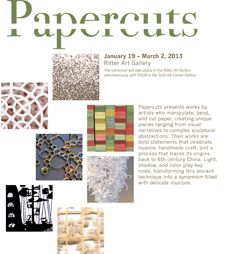 Website image for Papercuts
Website image for Papercuts

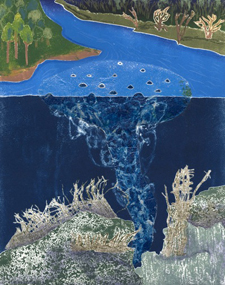 Barbara McPhail, Toxic Plume, 2010, monotype, 14 x 11 in. (artwork © Barbara McPhail; photograph by the artist)
Barbara McPhail, Toxic Plume, 2010, monotype, 14 x 11 in. (artwork © Barbara McPhail; photograph by the artist)
 Gertrude Käsebier, The Sketch, 1903, platinum print, 6¼ x 8½ in. University Museums, gift of Mason E. Turner Jr. (photograph by Jim Schneck)
Gertrude Käsebier, The Sketch, 1903, platinum print, 6¼ x 8½ in. University Museums, gift of Mason E. Turner Jr. (photograph by Jim Schneck)
